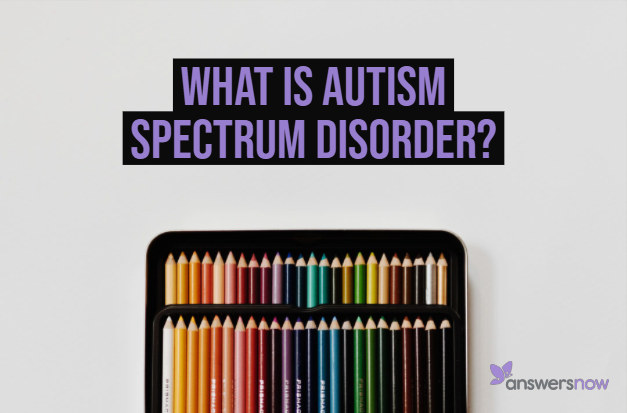What is Autism Spectrum Disorder?

Autism spectrum disorder is a lifelong condition of social impairment, communication deficits, and repetitive behaviors/interests.
It first appears early in a child’s life.
Keep in mind, this does not mean that the signs and symptoms of autism will be immediately visible when your child is an infant.
Often, the first signs aren’t often noticeable until a child reaches developmental milestones and misses them.
Understanding Autism Spectrum Disorder
What follows is a detailed summary of the important points–the key takeaways–to understand about autism spectrum disorder.
Read this, and you will be up to date on what autism spectrum disorder is and the clues that clinicians look for when deciding whether an autism diagnosis is appropriate.
This information comes from the 5th edition of the Diagnostic and Statistical Manual of Mental Disorders published by the American Psychiatric Association, the definitive manual that clinicians in the United States turn to when making diagnoses.
Key Takeaway 1: Autism Spectrum Disorder Affects Social Communication
The way an individual communicates to others through language–both verbally and nonverbally–is a crucial part of the communication criteria. Communication implies that one person provides information that is then interpreted by another person or a group of people.
For individuals with autism, outward communication with others can be very challenging, resulting in their attempts at communication often being misunderstood.
For instance, maintaining eye contact and mimicking other’s body language can also be difficult for a person with autism. It is also common for a person on the autism spectrum to display a limited range of facial expressions while communicating. This mismatch between words being used and the facial expressions being shown can quickly lead to confusion and misunderstandings.
Add to this the difficulty that individuals with autism have in developing fine motor skills, and it becomes clear how a combination of imprecise movements and a limited capability for verbal expression can lead to major communication challenges.
Key Takeaway 2: Autism Spectrum Disorder Affects Social Functioning
At its very core, autism spectrum disorder affects an individual’s ability to interact with others.
This can take a lot of different forms, such as an inability to easily pick up on social cues and decipher subtle meanings in others’ words and facial expressions.
This also extends to struggling to understand other people’s perspectives. In other words, people with autism can have a hard time understanding that others have “inner worlds” of their own.
To a parent, this may suggest that a person with autism has little empathy for others. It is important to address that this is not the case, only that individuals with autism may focus intensely on their own thoughts and select interests while “tuning out” the world around them.
As a result, this tendency to isolate and not seek out relationships with others can make children with autism stand out from their peers. Consequently, they may struggle to make friends until they develop the social skills to connect with their peers on a deeper, mutually beneficial level.
Key Takeaway 3: Autism Spectrum Disorder Involves a Narrow Range of Rigid Interests and Repetitive Movements
Specifically, behaviors must exist in at least two of the following categories:
1. Repetition
Repetition could mean a lot of different things, but some of the most common examples are repeating the same words over and over, using repetitive movements as a way to self-soothe, or arranging objects, such as toys, in order while playing.
The key takeaway here is that the behavior follows a noticeably repetitive pattern.
2. Rigid thinking / behaviors
Children with autism will tend to view the world as “black or white.” They will have a hard time seeing others’ points of view and will feel most comfortable when adhering to a strict schedule.
That means that changes in normal routines can be incredibly upsetting and produce reactions or temper tantrums that don’t seem appropriate given the situation.
3. Narrow range of fixed interests
Another common indication of autism spectrum disorder is a child only having a small number of fixed interests.
On top of having a very small number of interests, these interests can become areas of obsession, covering topics as wide-ranging as technology, dinosaurs, or the career statistics of professional athletes.
4. Strong reaction to and/or interest in sensory input
Another area that can quickly become overwhelming for a child with autism is his or her response to sensory stimuli. For some children, it’s loud noises that can be unbearable. For others, it’s bright lights or the feeling of certain types of fabric touching the skin.
On the other hand, sometimes it’s not a case of being overwhelmed by certain sensory stimuli; the opposite can also be true. Some children will be underwhelmed by sensory input, meaning they don’t react to certain auditory, visual, or tactile input.
Finally, it’s not always about how something feels–or doesn’t feel. Children with autism spectrum disorder may also exhibit strong obsessions or fascination with sensory stimuli.
Key Takeaway 4: To Receive a Diagnosis of Autism Spectrum Disorder, Symptoms Must Have Been Present from an Early Age
As was mentioned above, autism spectrum disorder is a lifelong condition; it does not simply appear and disappear at random throughout one’s life.
It first shows up in early childhood, during the earliest stages in a child’s development. Furthermore, these symptoms must not merely be a minor annoyance; they must significantly impact a child’s functioning across a number of different environments, such as at home, in school, out in public, or while interacting with peers.
Clinicians involved in the autism evaluation process will focus on these points when deciding on whether a diagnosis of autism spectrum disorder is appropriate.
Has your child already been diagnosed with autism spectrum disorder?
Our expert clinicians can help.
The AnswersNow app partners caregivers with personal, board-certified autism clinicians.
Click here to learn more, or click one of the download buttons below to start messaging with your AnswersNow clinician today!

